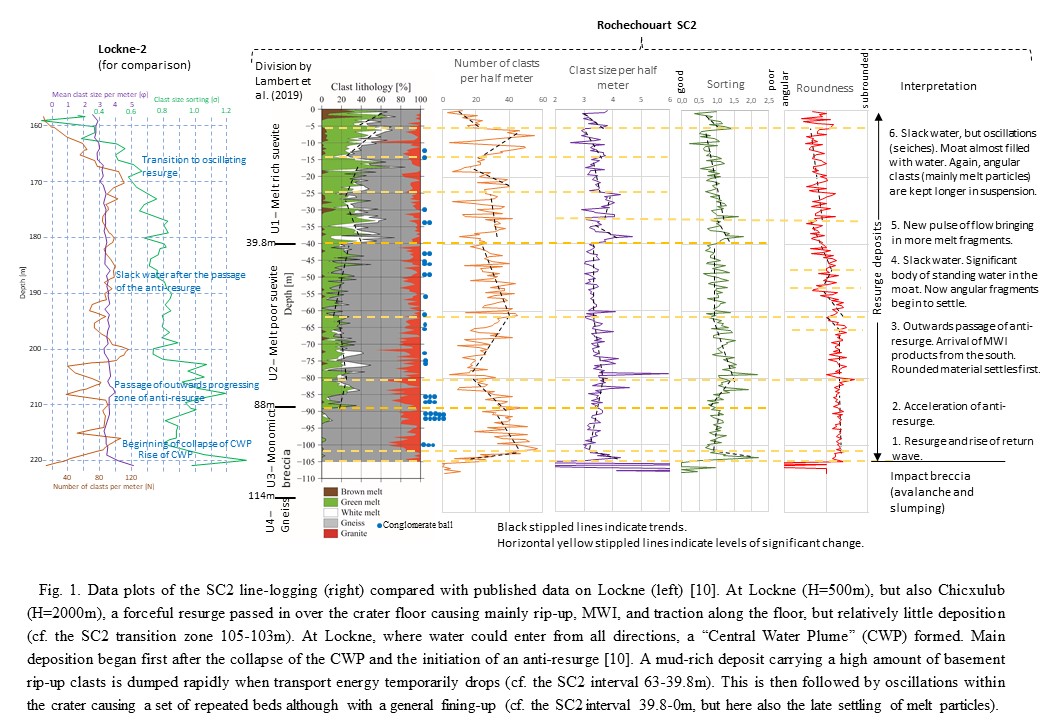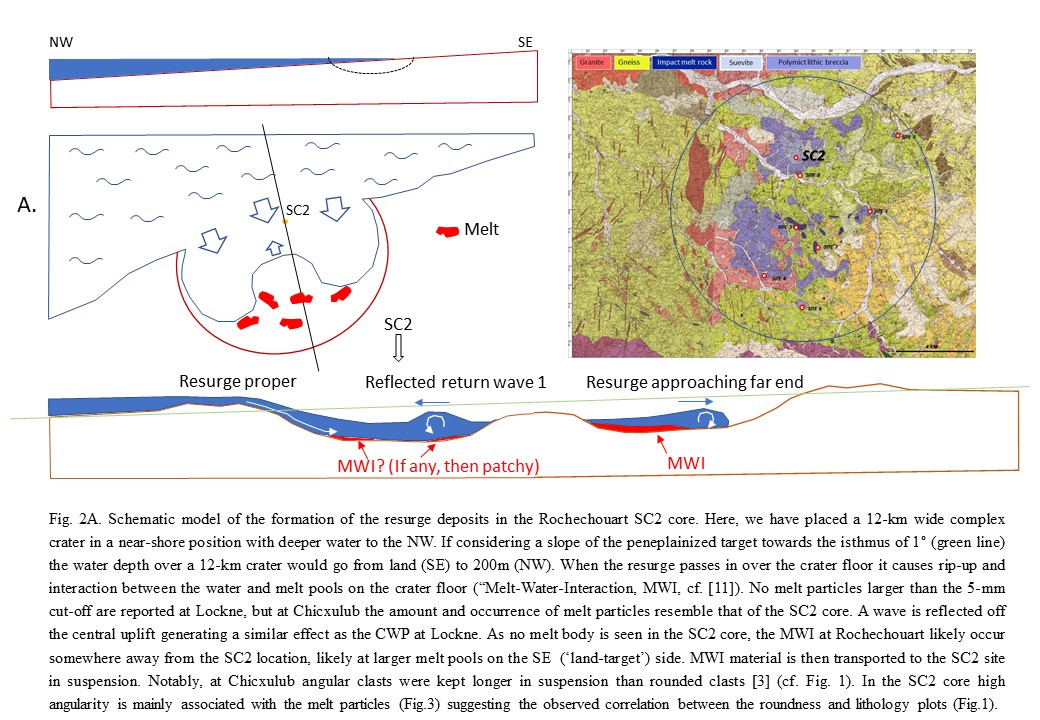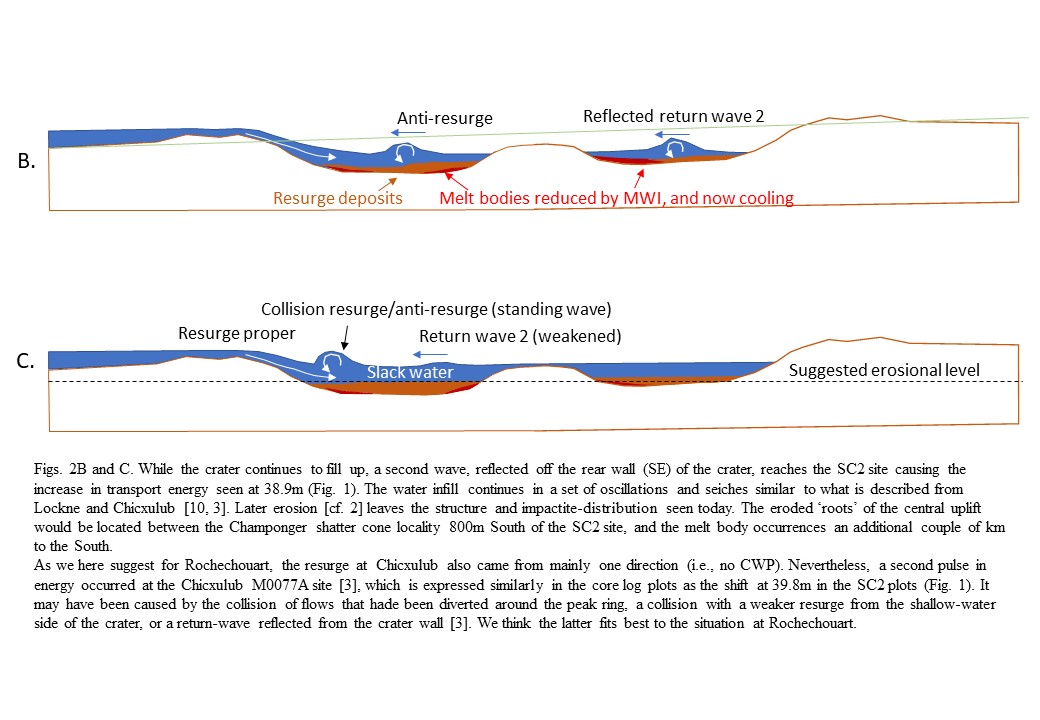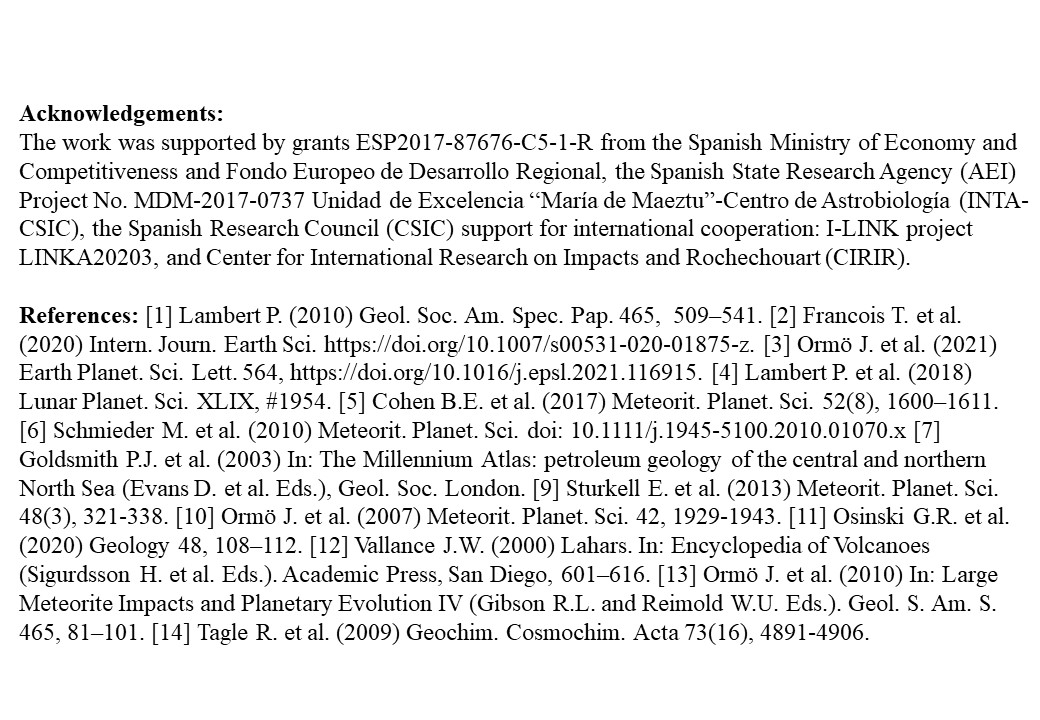Ocean Resurge Deposits at the Rochechouart Impact Crater, France: Hints to Target Environment and Event Magnitude.
- 1Centro de Astrobiologia (INTA-CSIC), Dept Planetology and Habitability, Torrejon de Ardoz, Spain (ormoj@cab.inta-csic.es)
- 2Earth Sciences Center, Gothenburg University, Sweden
- 3Center for International Research & Restitution on Impacts and on Rochechouart (CIRIR), France.
Introduction: The Late Triassic Rochechouart impact structure, Massif Central, France, has been suggested to be one of the largest impact structures in western Europe. A pre-erosion diameter of 40-50km has been proposed [1]. However, the lack of a distinct crater morphology hampers estimates of its dimensions and, thus, an assessment of the event magnitude. A deep erosional level is expected, ~1100 m of basement rocks have been eroded since exhumation was initiated in the Cretaceous [2]. However, a graded suevite at Chassenon (north-central part of the area of impactites) indicates a remarkably complete infill sequence [1]. The suevite resembles resurge deposits known to represent the uppermost parts of impact-generated infill sequences in marine-target craters (e.g., Lockne, Tvären, Chicxulub [3]). The 121.7m deep SC2 hole at Chassenon, intersects 88m of suevite and 25m of basement breccia before reaching a more intact gneissic basement [4]. The lower Rhaetian age of the event [5] places the impact paleogeographically at an isthmus between the Tethys Sea in the south and the Rhaetian Sea to the north [6] following a transgression initiated at that time [7].
Methods: The core logging of SC2 follows the same methodology (i.e., line-logging) as in the studies forming the base for Eq. 1 [3]. This allows analysis of the mode of deposition of the graded suevite, the timing of the impact in relation with the marine transgression, as well as the dimensions of the original pre-erosion crater.
Results: Of the 6002 recorded clasts 63.6% are gneiss, 10.9% granite, 18.4% green melt, 5.5% white melt, 0.9% brown melt, and 0.6% quartzite conglomerate balls. Target rock clasts (i.e., gneiss, granite, and conglomerate) occur relatively evenly throughout the logged section (Fig. 1). The most obvious variation is seen for melt particles.
In a zone between 105m and 103m the plots become organized after having been chaotic below 105m. A clear reverse grading (i.e., reduction in clast size and sorting but increase in clast frequency) occurs between 103m and 81m. Then follows a normally graded interval 81-63m. In the interval 63-39.8m there is again a decrease in number of clasts towards the top. As this is not accompanied with an increase in clast size, it is more likely a consequence of increased matrix content (i.e., mud). At 63m occurs the first obvious change in roundness with a general increase in angularity towards the top of the interval. A drastic shift in the clast frequency (increase), size (increase), sorting (reduction), and lithology (high melt particle content) occurs at 39.8m. The interval 38.9-0m is characterized by a set of repeated graded beds (reverse and normal), although sorting is following a generally improving trend. With a delay of about 7m (39.8-33m) roundness is again increasing in the lower part of the interval, but decreases slightly to the top.



Discussion: The plots allow comparisons with published data on other resurge deposits [3]. Of those, the Lockne-2 core is most similar with respect to clast frequency, size, and sorting variations (Fig. 1). In addition, the Chicxulub M0077A core is comparable with respect to lithology distribution and roundness variation [cf. 3]. The chaotic appearance of the plots below 105m indicates avalanche and slump deposits [cf. 9]. Interval 105-103m represents a short transition zone with initiation of transport and deposition in water [cf. 3]. Suspension deposits begin at 103m and dominates upwards. Figures 1 (right column) and 2 describe the proposed depositional processes and the dynamics of the water flow.
Deposits such as in SC2, Lockne-2 and Chicxulub M0077A indicate a transport as hyperconcentrated flows [cf. 3] with 20-60%vol of material in suspension [12]. Considering the relatively low amount of clasts per meter (58) in SC2 compared with Lockne-2 (85) and Chicxulub M0077A (72) [cf. 3] despite a similar mean clast size (-ϕ 3.4), most likely the sediment load was in the higher end of that span. The overall thickness of the SC2 resurge deposits (>103m) and a sediment load of 50%vol gives a flow depth of ~200m. Numerical simulations of resurge flows indicate the depth of the target sea to be in the same order [13]. Less water would generate a complex set of debris flows, if at all able to pass the elevated rim [cf. 3]. Thus, we can confirm that the Rochechouart impact was marine [cf. 6]. The paleogeography map by [7] shows the rapid formation of the isthmus and deposition of “shallow- to deep- marine carbonates” in the area. However, the absence of any sediment clasts in the SC2 resurge deposits (except for conglomerate balls) indicate insufficient time between the transgression and the impact for formation of sedimentary rock. An impact during the transgression phase is envisaged and fit with the lower Rhaetian age of the impact [5].
Sedimentological studies of resurge deposits from marine-target craters have shown a relation between mean clast frequency (Nmean), impactor diameter (d) and target water depth (H) that allows the estimate of any of these variables when the two others are known [3]:
Nmean=-15(d/H) +100 Eq. 1.
Applying Equation 1 with = 58, H = 200m gives a projectile size of ~560m. A 500m iron projectile, as suggested by [14], generates, according to the impact-effect calculator down2earth.eu [accessed May 2021], a 12km wide crater. This correlates well with the main distribution of impactites in the Rochechouart structure. Therefore, this diameter is used in the process reconstruction in Figs. 2A-C.
Conclusions: Sedimentological analysis of the suevite deposits in the SC2 core near Chassenon confirms a shallow marine target environment for the Rochechouart impact. More generally the results can be used to further constrain the paleotopography and the erosional history of the Western edge of the French Massif Central, the timing of the event relative to the transgression, and the event magnitude.

How to cite: Ormö, J., Sturkell, E., and Lambert, P.: Ocean Resurge Deposits at the Rochechouart Impact Crater, France: Hints to Target Environment and Event Magnitude. , European Planetary Science Congress 2021, online, 13–24 Sep 2021, EPSC2021-55, https://doi.org/10.5194/epsc2021-55, 2021.

